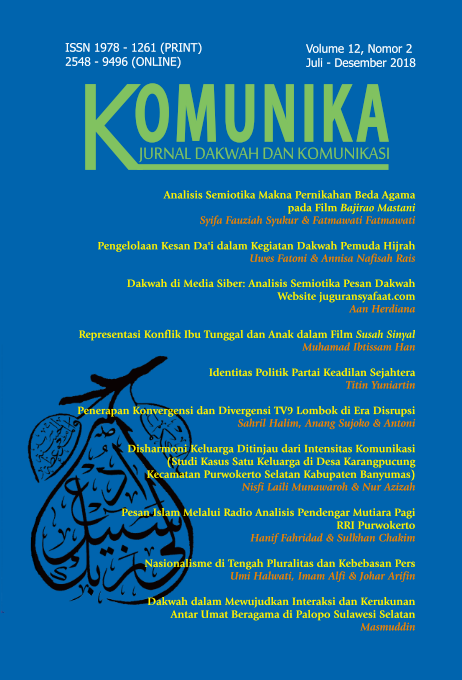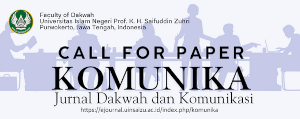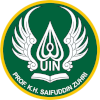Dakwah di Media Siber
Analisis Semiotika Pesan Dakwah Website juguransyafaat.com
DOI:
https://doi.org/10.24090/komunika.v12i2.1315Keywords:
Da'wa, Semiotics Analysis, Cyber Media, Internet, juguransyafaat.comAbstract
The Internet gives a new universal space for sharing information, and interacting. The use of the Internet network, in the context of da’wah is a breakthrough for the efficiency and effectiveness of da’wah. The birth of Islamic sites is a must for today’s adult da’wah activists. However, da’wah should evolve and adapt to the ever-changing character of society, so da’wah can be well received. One of the sites containing Islamic values is juguransyafaat.com. The method used in this study is semiotics, where this theory is used to interpret the meaning of the text, whether in the form of words or images. The result of this research explains that through the writings or articles it is seen that the discourse presented in juguransyafaat.com gives the characteristics of the propagation material, which when classified into three major parts, which in cludes aqidah, life, and morals to create innovative thinking which is expected to change the establishment of the understanding of religion from a closed understanding to an open religious understanding.Downloads
Download data is not yet available.
References
Baldwin, J. R., & Moffitt, M. A. (2004). Communication Theories for Everyday Life. Boston: Pearson Education.
Basit, A. (2006). Wacana Dakwah Kontemporer. Yogyakarta: Pustaka Pelajar.
Bob, K., & Sooknanan, P. (2014). The Impact of Computer Mediated Communication (CMC) on Productivity and Efficiency in Organizations: A Case Study of an Electrical Company in Trinidad and Tobago Advances in Journalism and Communication. Trinidad and Tobago.
Cantoni, L., & Tardini, S. (2006). Internet. New York: Routledge.
Departemen Pendidikan Nasional. (2004). Kamus Besar Bahasa Indonesia. Jakarta: Balai Pustaka.
Fiske, J. (2014). Pengantar Ilmu Komunikasi. Jakarta: Rajawali Press.
Ilahi, W. (2010). Komunikasi Dakwah. Bandung: Rosdakarya.
Juguransyafaat. (2017, 11 14). Maiyah Laboratorium Persaudaraan. Retrieved from Juguransyafaat: http://juguransyafaat.com/2017/maiyah-laboratorium-persaudaraan/
Jurugran Syafaat. (n.d.). Retrieved 01 24, 2018, from Jurugan Syafaat: http://juguransyafaat.com
Kusnawan, A. (2004). Ilmu Dakwah (Kajian Berbagai Aspek). Bandung: Pustaka Bani Quraisy.
Muhyidin, A. (2002). Metode Pengembangan Dakwah. Bandung: Pustaka Setia.
Nasrullah, R. (2016). Teori dan Riset Media Siber. Jakarta: Prenada Grup.
Sudirjo, S., & dkk. (2004). Mozaik Teknologi Pendidikan. Jakarta: Universitas Negeri Jakarta.
Suparno, B. A., Sosiawan, E. A., & Tripambudi, S. (2012). Computer Mediated Communication. Jurnal Ilmu Komunikasi, 85-102.
Syafaat, R. J. (2018, 02 02). MAMPIR MEDANG (70) : Dua Milyar. Retrieved from Juguran Syafaat: http://juguransyafaat.com/2018/mampir-medang-70-dua-milyar/
Syafaat, R. J. (2018, 02 09). MAMPIR MEDANG (71) : Peristiwa Alamiah, peristiwa Ilahiah. Retrieved from Juguransyafaat: http://juguransyafaat.com/2018/mampir-medang-71-peristiwa-alamiah-peristiwa-ilahiah/
Syafaat, R. J. (2018, 03 13). Pesan Simbah. Retrieved from Juguran Syafaat: http://juguransyafaat.com/pesan-simba
Basit, A. (2006). Wacana Dakwah Kontemporer. Yogyakarta: Pustaka Pelajar.
Bob, K., & Sooknanan, P. (2014). The Impact of Computer Mediated Communication (CMC) on Productivity and Efficiency in Organizations: A Case Study of an Electrical Company in Trinidad and Tobago Advances in Journalism and Communication. Trinidad and Tobago.
Cantoni, L., & Tardini, S. (2006). Internet. New York: Routledge.
Departemen Pendidikan Nasional. (2004). Kamus Besar Bahasa Indonesia. Jakarta: Balai Pustaka.
Fiske, J. (2014). Pengantar Ilmu Komunikasi. Jakarta: Rajawali Press.
Ilahi, W. (2010). Komunikasi Dakwah. Bandung: Rosdakarya.
Juguransyafaat. (2017, 11 14). Maiyah Laboratorium Persaudaraan. Retrieved from Juguransyafaat: http://juguransyafaat.com/2017/maiyah-laboratorium-persaudaraan/
Jurugran Syafaat. (n.d.). Retrieved 01 24, 2018, from Jurugan Syafaat: http://juguransyafaat.com
Kusnawan, A. (2004). Ilmu Dakwah (Kajian Berbagai Aspek). Bandung: Pustaka Bani Quraisy.
Muhyidin, A. (2002). Metode Pengembangan Dakwah. Bandung: Pustaka Setia.
Nasrullah, R. (2016). Teori dan Riset Media Siber. Jakarta: Prenada Grup.
Sudirjo, S., & dkk. (2004). Mozaik Teknologi Pendidikan. Jakarta: Universitas Negeri Jakarta.
Suparno, B. A., Sosiawan, E. A., & Tripambudi, S. (2012). Computer Mediated Communication. Jurnal Ilmu Komunikasi, 85-102.
Syafaat, R. J. (2018, 02 02). MAMPIR MEDANG (70) : Dua Milyar. Retrieved from Juguran Syafaat: http://juguransyafaat.com/2018/mampir-medang-70-dua-milyar/
Syafaat, R. J. (2018, 02 09). MAMPIR MEDANG (71) : Peristiwa Alamiah, peristiwa Ilahiah. Retrieved from Juguransyafaat: http://juguransyafaat.com/2018/mampir-medang-71-peristiwa-alamiah-peristiwa-ilahiah/
Syafaat, R. J. (2018, 03 13). Pesan Simbah. Retrieved from Juguran Syafaat: http://juguransyafaat.com/pesan-simba
Downloads
Published
2018-07-04
Issue
Section
Articles
License
Authors who publish with this journal agree to the following terms:
- Authors retain copyright and grant the journal right of first publication with the work simultaneously licensed under a Creative Commons Attribution-ShareAlike 4.0 International License that allows others to share the work with an acknowledgement of the work's authorship and initial publication in this journal.
- Authors are able to enter into separate, additional contractual arrangements for the non-exclusive distribution of the journal's published version of the work (e.g., post it to an institutional repository or publish it in a book), with an acknowledgement of its initial publication in this journal.
- Authors are permitted and encouraged to post their work online (e.g., in institutional repositories or on their website) prior to and during the submission process, as it can lead to productive exchanges, as well as earlier and greater citation of published work (See The Effect of Open Access).

























